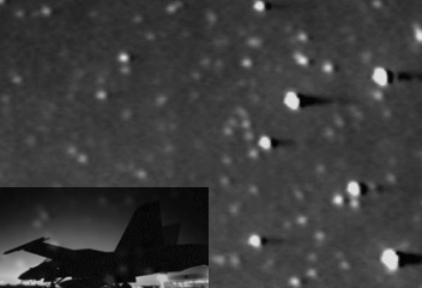Explanation: In an era of blossoming ground and space-based observatories, astronomers are also pushing the envelope with airborne instrumentation - successfully capturing an asteroid occultation from a high performance jet aircraft. This blinking animation represents two digitized frames from inflight data of asteroid number 308, Polyxo, passing in front of or occulting a faint star near the center of the field. The camera used, known as the SouthWest Ultraviolet Imaging System (SWUIS) -A, was mounted in the cockpit of a NASA F/A-18 jet (inset lower left). A former US Navy fighter aircraft, the F/A-18 was able to maneuver to the precise position to record the occultation while cruising above clouds and much of Earth's obscuring atmosphere. Using the SWUIS-A data to time the occultation will reveal the size of the asteroid which is otherwise too small to be imaged by even the orbiting Hubble Space Telescope. Future SWUIS-A airborne missions may include a hunt for Vulcanoids, a suspected population of small asteroids circling the Sun inside the orbit of Mercury.
1999 2000 2001 2002 2003 2004 2005 2006 2007 2008 2009 2010 2011 2012 2013 2014 2015 2016 2017 2018 2019 2020 2021 2022 2023 2024 2025 |
Yanvar' Fevral' Mart Aprel' Mai Iyun' Iyul' Avgust Sentyabr' Oktyabr' Noyabr' Dekabr' |
NASA Web Site Statements, Warnings, and Disclaimers
NASA Official: Jay Norris. Specific rights apply.
A service of: LHEA at NASA / GSFC
& Michigan Tech. U.
|
Publikacii s klyuchevymi slovami:
F-18 - astronomy - pokrytiya zvezd
Publikacii so slovami: F-18 - astronomy - pokrytiya zvezd | |
Sm. takzhe:
Vse publikacii na tu zhe temu >> | |
